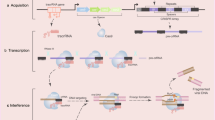Abstract
Formaldehyde-induced sister chromatid exchanges (SCE) in vitro and the influence of the exogenous metabolizing systems, S9 mix and primary rat hepatocytes, were studied. The SCE-frequency in V79 cells was dose dependent. A three- to four-fold increase at non-toxic doses was observed. However, in the presence of an exogenous metabolizing system, the number of formaldeyhde-induced SCE decreased. S9 mix as well as hepatocytes reduced the SCE frequency to nearly that of the control range. It could be demonstrated that the reduction was not due to an unspecific binding of formaldehyde to macromolecules of the added S9 mix. The decrease in genotoxic effects, due to rapid metabolisation of formaldehyde in vitro and in vivo, explains the differences between results obtained in the in vitro experiments — performed without metabolizing systems — and in vivo results.
Similar content being viewed by others
References
Ames BN, McCann J, Yamasaki E (1975) Methods for detecting carcinogens and mutagens with the Salmonella/mammalian-microsome mutagenicity test. Mutat Res 31: 347–364
Auerbach C, Moutschen-Dahmen M, Moutschen J (1977) Genetic and cytogenetical effects of formaldehyde and related compounds. Mutat Res 39: 317–362
Bermudez E, Couch DB, Tillery D (1982) The use of primary rat hepatocytes to achieve metabolic activation of promutagens in the Chinese hamster ovary/hypoxanthine-guanine phosphoribosyl transferase mutational assay. Environ Mutagen 4: 55–64
BMFJG — Bundesminister für Junged, Familie und Gesundheit (ed.) (1984) Formaldeyhd. Gemeinsamer Bericht des Bundesgesundheitsamtes, der Bundesanstalt für Arbeitsschutz und des Umweltbundesamtes. Schriftenreihe des Bundesministers für Jugend, Familie und Gesundheit, Band 148, Kohlhammer Verlag, Stuttgart, ISBN 3-17-008821-1
Casanova-Schmitz M, Heck H (1983) Effects of formaldehyde exposure on the extractability of DNA from proteins in the rat nasal mucosa. Toxicol Appl Pharmacol 70: 121–132
Casanova-Schmitz M, Starr TB, Heck H (1984) Differentiation between metabolic incorporation and covalent binding in the labeling of macromolecules in the rat nasal mucosa and bone marrow by inhaled (14C)- and (3H)formaldehyde. Toxicol Appl Pharmacol 76: 26–44
Doolittle DJ, Butterworth BE (1984) Assessment of chemicallyinduced DNA repair in rat tracheal epithelial cells. Carcinogenesis 5: 773–779
Feldman MY (1973) Reactions of nucleic acids and nucleoproteins with formaldehyde. Prog Nucl Acid Res Mol Biol 13: 1–49
Galloway SM, Bloom AD, Resnick M, Margolin BH, Nakamura F, Archer P, Zeiger E (1985) Development of a standard protocol for in vitro cytogenetic testing with Chinese hamster ovary cells: Comparison of results for 22 compounds in two laboratories. Environ Mutagen 7: 1–51
Heck H, Casanova-Schmitz M (1984) The relevance of disposition studies to the toxicology of formaldehyde. CIIT Activities, 4: 2–5
Kerns WD, Pavkov KL, Donofrio DJ, Gralla EJ, Swenberg JA (1983) Carcinogenicity of formaldehyde in rats and mice after long-term inhalation exposure. Cancer Res 43: 4372–4392
Kligerman AD, Phelps MC, Erexson GL (1984) Cytogenetic analysis of lymphocytes from rats following formaldehyde inhalation. Toxicol Lett 21: 241–246
Kreiger RA, Garry VF (1983) Formaldehyde-induced cytotoxicity and sister-chromatid exchanges in human lymphocyte cultures. Mutat Res 120: 51–55
Latt SA, Allen J, Bloom SE, Carrano A, Falke E, Kram E, Schneider E, Wolff R, Schreck R, Tice R, Whitfield B (1981) Sister chromatid exchanges: A report of the Gene-Tox Program. Mutat Res 87: 17–62
Lowry OH, Rosenbrough NJ, Farr AL, Randall RJ (1951) Protein measurement with the Folin reagent. J Biol Chem 193: 265–275
Nash T (1953) The colorimetric estimation of formaldehyde by means of the Hantzsch reaction. Biochem J 55: 416–421
Natarajan AT, Darroudi F, Bussman CJM, Kesteren-van Leeuwen AC (1983) Evaluation of the mutagenicity of formaldeyhde in mammalian cytogenetic assays in vivo and vitro. Mutat Res 122: 355–360
Obe G, Beek B (1979) Mutagenic activity of aldehydes. Drug Alcohol Depend 4: 91–94
Swenberg JA, Kerns WD, Mitchell RI, Gralla EJ, Pavkov KL (1980) Induction of squamous cell carcinomas of the rat nasal cavity by inhalation exposure to formaldehyde vapor. Cancer Res 40: 3398–3402
Swenberg JA, Barrow CS, Boreiko CJ, Heck H, Levine RJ, Morgan KT, Starr TB (1983) Non-linear biological responses to formaldehyde and their implications for carcinogenic risk assessment. Carconogenesis 4: 945–952
Author information
Authors and Affiliations
Rights and permissions
About this article
Cite this article
Basler, A., v. d. Hude, W. & Scheutwinkel-Reich, M. Formaldehyde-induced sister chromatid exchanges in vitro and the influence of the exogenous metabolizing systems S9 mix and primary rat hepatocytes. Arch Toxicol 58, 10–13 (1985). https://doi.org/10.1007/BF00292609
Received:
Accepted:
Issue Date:
DOI: https://doi.org/10.1007/BF00292609



